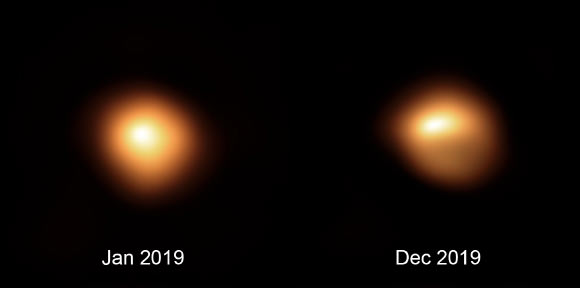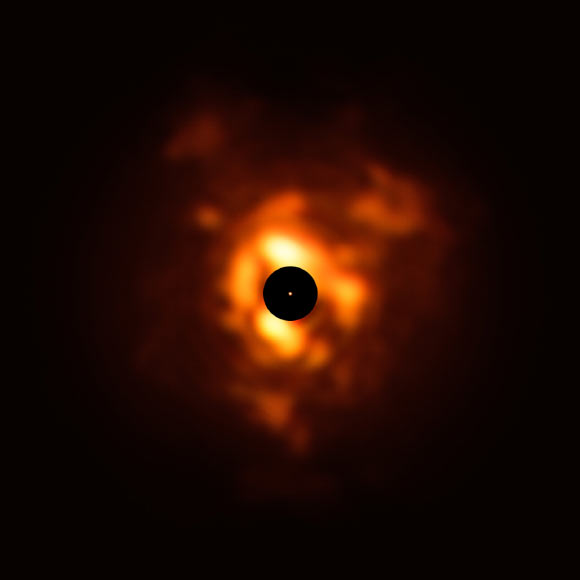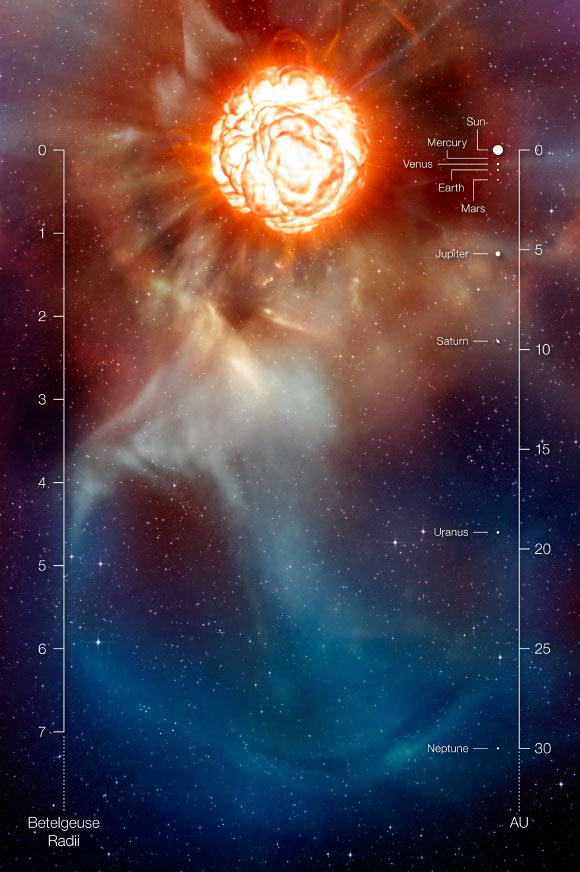Betelgeuse: VLT Observes Dimming Supergiant Star | Astronomy – Sci-News.com
Astronomers using two instruments on ESO’s Very Large Telescope (VLT) have captured new images of a red supergiant star called Betelgeuse. The images show not only the fading red supergiant but also how its apparent shape is changing.

This comparison image shows Betelgeuse, which is also known as Alpha Orionis, before and after its unprecedented dimming. The observations, taken with the SPHERE instrument on ESO’s Very Large Telescope in January and December 2019, show how much the star has faded and how its apparent shape has changed. Image credit: ESO / M. Montargès et al.
Betelgeuse, the second brightest star in the constellation Orion, is a red supergiant located approximately 650 light-years away from Earth.
With a radius around 1,400 times larger than the Sun’s, Betelgeuse is one of the biggest stars known.
It is also one of the most luminous stars known, emitting more light than 100,000 Suns.
With an age of only 8 million years, Betelgeuse is already nearing the end of its life and is soon doomed to explode as a supernova. When it does, the supernova should be seen easily from Earth, even in broad daylight.
Betelgeuse began to dim in September 2019. At the time of writing the supergiant star is at about 36% of its normal brightness, a change noticeable even to the naked eye.

This image, obtained with the VISIR instrument on ESO’s Very Large Telescope, shows the infrared light being emitted by the dust surrounding Betelgeuse in December 2019. The clouds of dust, which resemble flames in this dramatic image, are formed when the star sheds its material back into space. The black disk obscures the star’s center and much of its surroundings, which are very bright and must be masked to allow the fainter dust plumes to be seen. The orange dot in the middle is the SPHERE image of Betelgeuse’s surface, which has a size close to that of Jupiter’s orbit. Image credit: ESO / P. Kervella / M. Montargès et al / Eric Pantin.
KU Leuven astronomer Miguel Montargès and colleagues have been observing the star with VLT since December 2019, aiming to understand why it’s becoming fainter.
Among the first observations to come out of their campaign is a stunning new image of Betelgeuse’s surface, taken late last year with the Spectro-Polarimetric High-contrast Exoplanet Research (SPHERE) instrument.
Dr. Montargès’ team also happened to observe the star with SPHERE in January 2019, before it began to dim, giving us a before-and-after picture of Betelgeuse.
Taken in visible light, the images highlight the changes occurring to the star both in brightness and in apparent shape.
Many astronomy enthusiasts wondered if Betelgeuse’s dimming meant it was about to explode.
“The two scenarios we are working on are a cooling of the surface due to exceptional stellar activity or dust ejection towards us,” Dr. Montargès said.
“Of course, our knowledge of red supergiants remains incomplete, and this is still a work in progress, so a surprise can still happen.”

This artist’s impression shows Betelgeuse as it was revealed thanks to different state-of-the-art techniques on ESO’s Very Large Telescope, which allowed two independent teams of astronomers to obtain the sharpest ever views of the supergiant star. They show that the star has a vast plume of gas almost as large as our Solar System and a gigantic bubble boiling on its surface. These discoveries provide important clues to help explain how these mammoths shed material at such a tremendous rate. The scale in units of the radius of Betelgeuse as well as a comparison with the Solar System is also provided. Image credit: ESO / L. Calçada.
Another new image, obtained with the VISIR instrument on the VLT, shows the infrared light being emitted by the dust surrounding Betelgeuse in December 2019.
The observations were made by Observatory of Paris astronomer Pierre Kervella and his colleagues.
“The wavelength of the image is similar to that detected by heat cameras,” the astronomers said.
“The clouds of dust, which resemble flames in the VISIR image, are formed when the star sheds its material back into space.”






